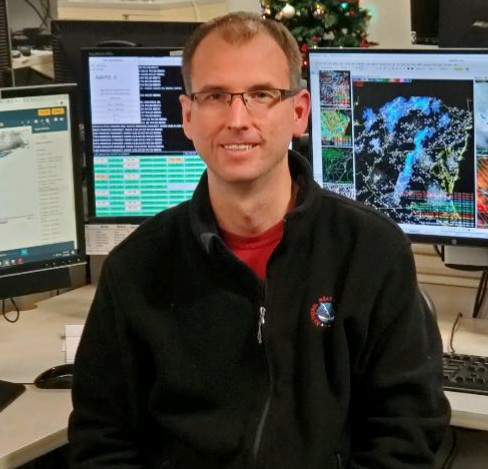Andrew Snyder
As a Lead Meteorologist, Andrew serves as the shift leader. The National Weather Service
keeps watch over the weather 24/7/365, meaning rotating shifts are necessary. On a
routine basis, they provide a variety of weather, water, and climate related services.
In addition to public forecast information (high temperature, sky cover, snow amounts,
etc.), they provide marine forecasts for the Maryland Chesapeake Bay and Tidal Potomac
River, tide level forecasts for a number of shoreline locations, aviation forecasts
for six airports, and (with the assistance of the Mid Atlantic River Forecast Center)
river level forecasts for the Potomac, Shenandoah, and Rappahannock basins. Through
their forecasts and observational analysis, they are the official source for weather
watch and warning information for the greater Baltimore and Washington region. Andrew
and his team also provide weather briefings and other decision support services to
government partners so they can prepare and plan to keep the citizens of the area
safe during hazardous weather while ensuring responses are proactive instead of reactive.
Finally, they collect weather observations from volunteer observers and local airports
for inclusion in the national climate database.
In addition to his routine duties, Andrew is also the office program leader for the
aviation, training, and Graphical Forecast Editor (software with which we edit the
forecast) programs. That means he must ensure the program areas run efficiently, remain
up to date, and that staff are sufficiently trained. Some of his more interesting
work occurs with the aviation program. Andrew keeps track of verification statistics,
maintains the aviation forecast software, and keeps in touch with aviation users.
Before the pandemic, they would annually visit the major airport air traffic control
towers to observe how their forecasts were being used and to solicit feedback on their
usefulness. Andrew’s team also recently created an aviation "users group" consisting
of partners from commercial airlines, business aviation, local airports, and air traffic
control facilities. In the inaugural meeting in November 2019, they discussed the
biggest weather challenges in the region, national weather service products, suggestions
for improvements, and forecasting best practices. Andrew and his team felt this endeavor
was successful, as several suggestions by their partners have already made it into
our national policy directive!

